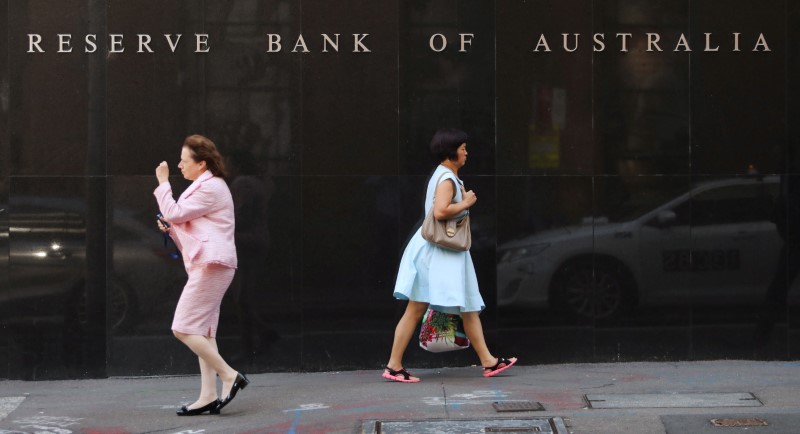 © Reuters. Two women walk next to the Reserve Bank of Australia headquarters in central Sydney
© Reuters. Two women walk next to the Reserve Bank of Australia headquarters in central SydneyBy Wayne Cole
SYDNEY (Reuters) – Australia’s central bank left interest rates at historic lows on Tuesday, predicting inflation would remain muted even as the economy gained speed this year in a clear sign a hike was still a distant prospect.
In a decision that surprised no one, the Reserve Bank of Australia (RBA) kept benchmark rates at 1.5 percent for a 21st successive month, the longest spell of inactivity since 1990.
Some analysts had thought it might rein in its optimism on the economy given a soft ending to last year. Instead, the central bank stood by forecasts that growth would “average a bit above 3 percent in 2018 and 2019.”
Annual gross domestic product (GDP) growth had slowed to 2.4 percent in the December quarter as bad weather dampened activity and offset strength in consumer and government spending.
“The Bank’s central forecast for the Australian economy remains for growth to pick up,” said RBA Governor Philip Lowe after the bank’s May policy meeting.
Business conditions were positive, business and public investment spending were on the rise and export growth was expected to accelerate, Lowe said.
The central bank will formerly update its forecasts in a quarterly statement due out on Friday.
Lowe also stuck with his refrain that any rise in inflation would only be gradual, wrongfooting some analysts who had thought the RBA would nudge up its forecasts.
While the official measure of consumer prices was subdued in the first quarter at an annual pace of 1.9 percent, there was a slight uptick in underlying inflation.
There was new evidence of emerging price pressures in surveys of manufacturing out on Tuesday. While firms reported strong sales, orders and employment they also complained of rising input prices and a lack of spare capacity.
“Our concerns about capacity pressures remain. These pressures are helping support labour demand, but inflation risks are rising as well,” said CBA chief economist, Michael Blythe.
“The indications of a modest turnaround in the recent CPI data appear to be continuing into Q2,” he added.
RATE ROAD BLOCKED BY DEBT MOUNTAIN
Lowe has long cautioned that the next move in rates is more likely to be up than down, but so far has emphasised that the central bank’s board saw no strong case for a hike anytime soon.
Investors are wagering there is just a one-in-five chance of a hike by December and a move to 1.75 percent is not fully priced in until July next year. [AU/INT]
Arguing for patience on tightening is a A$1.7 trillion mountain of mortgage debt held by households, already burdened by near-record growth in wages.
Policy makers have made it abundantly clear they recognise that higher rates will hurt many households more than in the past, particularly now that home prices are turning lower.
Figures out from property consultant CoreLogic said on Tuesday prices for the combined capital cities slipped 0.4 percent in March, the seventh straight month of decline.
That left prices down 0.3 percent for the year, the first negative reading since late 2012 and a definitive end to a five-year boom in values.
Regulators began the cool down with tighter rules on lending, but recently banks have also been raising borrowing requirements amid revelations of widespread malpractices on loans and financial advice.
“The weakness in prices, with more to go, is consistent with our view that the RBA will leave rates on hold out to 2020,” said AMP chief economist Shane Oliver.
“The weakness is now at levels where the RBA started cutting rates in 2008 and 2011.”
Source: Investing.com




























